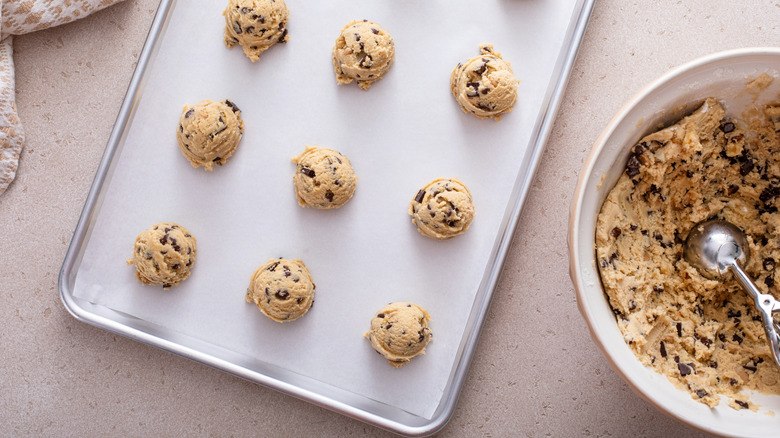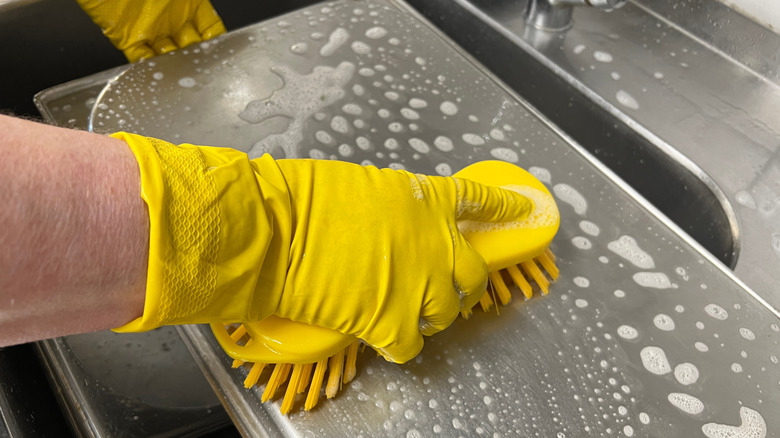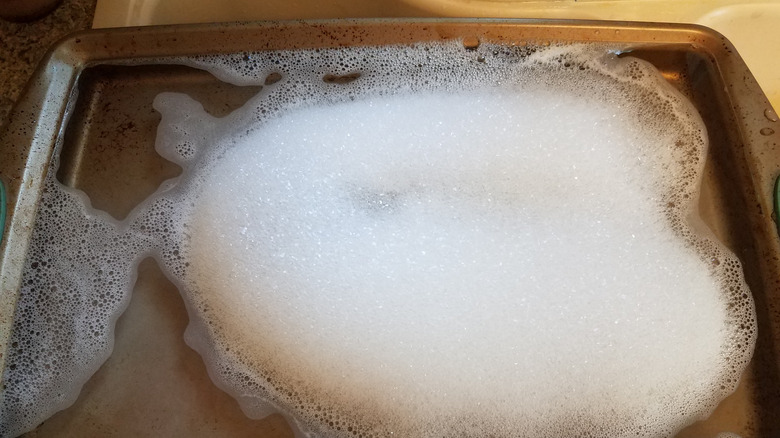The Easiest Way To Ruin A Baking Sheet Is A Popular Mistake
Whether it's baking a batch of your favorite cookies or roasting chicken and veggies for a sheet-pan meal, your trusty baking sheet does plenty of heavy lifting in the kitchen. It's hardly surprising that this indispensable bakeware item gets dirty in a hurry. From burned-on dough to sticky sauce residue, cleaning a sheet pan is often a challenge. Unfortunately, the most common way to ruin a baking sheet is to take a common shortcut when cleaning it — that is, tossing it in the dishwasher.
Dishwashers expose anything you put in them to powerful jets of scalding water and potent dish detergents, all of which can cause long-term damage to a baking sheet. As a result, your bakeware may become warped, discolored, and scratched. Putting non-stick and some aluminum baking sheets in the dishwasher is particularly problematic, as these materials are especially vulnerable to harsh cleaning conditions.
If you want your baking sheets to last through countless batches of pastries and fajita filling, you should hand-wash them in the kitchen sink. However, it's important to use the right methods and supplies — scrubbing and soaking with mild soap and gentle cleaners. Using overly harsh or abrasive cleaning products is one of the major mistakes everyone makes when cleaning baking sheets.
Hand-washing baking sheets is best for regular cleaning
If you can't see any caked-on food or stubborn stains, hand-washing with water and soap is typically enough to bring your dirty baking sheets back to life. Allow the pan to cool completely before picking it up, and then wash it with a gentle, non-abrasive dish soap and hot water. Use a cleaning cloth or sponge to spread the soap over the entire surface of the pan. Avoid harsh cleaning tools, such as steel wool, which can damage the baking sheet's finish.
If you need more elbow grease to remove really sticky residue from your baking sheet, opt for a soft bristled brush or nylon cleaning pad. These mildly abrasive tools allow you to scrub the pan without scratching it. Once your baking sheet is clean, rinse it and dry it thoroughly. Any lingering moisture can cause water spots, making the pan vulnerable to rust when it's in storage. Use a clean kitchen towel to dry your bakeware before you put it back in the kitchen cabinet. A paper towel works, too.
Soak baking sheets with stubborn stains or residue
In some cases, a standard clean with hot, soapy water won't be enough to get your baking sheet spotless. If your pan has burnt-on residue, you'll have an easier time removing it while it's still warm and soft. After you've removed the pan for the oven, allow it to cool slightly (it can be warm to the touch, but not burning), and then use a folded kitchen towel to wipe away the residue. Soaking is another way to soften stuck-on residue and make it easier to remove. Sit the baking sheet in a sink and cover it with hot water. Leave it in there for 30 to 60 minutes — if you set a timer for less than 15 minutes, you're soaking your dishes wrong. Then, use a non-metal scouring pad and some mild dish soap to scrub the pan. Add more hot water as needed.
For stains and residue that won't come off even after soaking, a mixture of baking soda and hydrogen peroxide may help to lift everything, making scrubbing easier. Combine three parts baking soda with one part hydrogen peroxide to form a paste, then spread it over the stains or residue on your baking sheet. Allow the solution to sit on the pan for at least two to three hours, though you can leave it on overnight if you need to. Take your trusty nylon pad in hand and gently scrub at the caked-on grime. After you've removed everything, hand wash the pan with warm, soapy water, then fresh water, and dry it thoroughly as you normally would.


